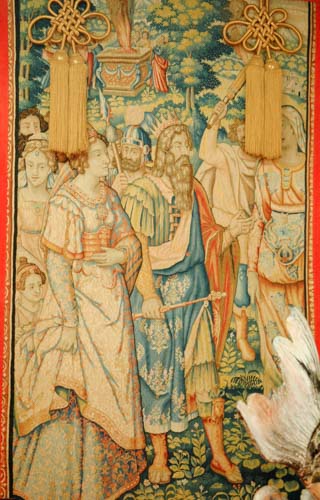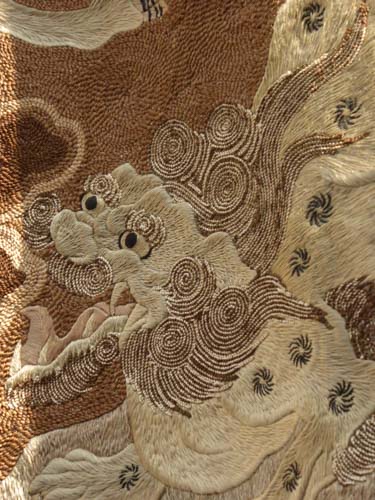My Gion Matsuri fieldwork began in mid-July 1993 when I was working as a regional correspondent for The Japan Times newspaper. I also lived in the heart of the Gion Matsuri yamaboko floats neighborhood. Every time I walked out my door, the treasures adorning the yamaboko bedazzled me. The Gion Matsuri textiles, in particular, captured my attention. Where were they from? What stories did they tell? How did they end up in the Gion Festival? I wondered.
I wrote two articles for The Japan Times about the July 1993 Gion Festival. Despite the passage of time, these articles still provide valuable background for the Gion Matsuri we enjoy today. I share the first one with you here, and stay tuned for the second one, to come.
Drive Starts to Save Gion Float Tapestries
By Catherine Pawasarat
Regional correspondent
KYOTO – Organizers of the annual Gion Festival, held here last week, have started replacing tapestries on the event’s floats with replicas amid international calls to preserve the original antique treasures.
Since 1985, experts from the Metropolitan Museum of Art in New York and the Washington D.C. Dyeing and Weaving Museum have studied 297 rugs, tapestries and other textiles displayed in the Gion Festival.
Their research has revealed that some of the pieces, which must brave the elements every year during the festival procession, are artworks of international importance worthy of preservation in a museum.
“There are so many of these tapestries that they’re considered folk art instead of important works of art,” said Nobuko Kajitani, textile conservator from the Metropolitan.
Even the government’s Cultural Properties Protection Department does not appreciate the value of the pieces, she said during a visit here last week to finish a book on the festival to be published by the museum next year.
“Medieval carpets shouldn’t be nailed to the front of floats in the sun and driving rain. Some of these carpets are extremely rare and should be properly mounted and preserved behind glass,” said American Jeremy Pine, an antique textiles expert based in Hong Kong.
The Gion Matsuri textiles are owned and cared for by each of the 32 neighborhood associations that have a float in the Gion Festival. “Some take care of the textiles very well, others don’t. Some are too fragile or valuable to be hung as they are – they need to be properly stored, and that’s costly,” Kajitani said.
Although the neighborhood associations realize the textiles should be specially cared for, Kajitani pointed out that the groups have neither the knowledge nor the time to do so.
Two of the neighborhood associations display copies instead of the originals, which are kept in storage and sometimes displayed to the public. Four others are currently having copies made, a timely and expensive process.
Copying the Koi Yama neighborhood association’s tapestry, designated an Important Cultural Asset, will cost 120 million yen when completed, said Osamu Higuchi, the association director.
Of the money spent to date, the association has paid approximately two thirds, the central government one fourth, and the prefectural and municipal governments the remaining amount.
“It was discovered that the tapestry was more important than we thought, so we decided to have it copied. Because weaving is a strong Kyoto industry, we could copy it here,” Higuchi said.
But Kajitani questioned the competence of the copying and repairing methods presently used in Kyoto, saying they are not oriented toward museum quality.
The Koi Yama association’s 16th-century tapestry is of Belgian origin. It was brought to Japan from Rome via Acapulco and Manila after Pope Paul V presented it to a vassal of Date Masamune, ruler of the Oshu-Date-han fiefdom, the present Tohoku region.
Many of the tapestries have similar romantic origins, Pine said, though most are thought to have been brought from China and India.
The historical and artistic value of the Gion Festival textiles is not fully appreciated, said Pine, who believes the pieces are worth millions of dollars.
Image at right: Koi Yama‘s Gobelin tapestry was one of the first to be discovered to have international historic and cultural value.

“But I think (the neighborhood associations) are headed in the right direction. Except for pieces that have not yet been properly identified, I didn’t see any of the especially valuable pieces hanging on the floats today,” Pine said last week.
Image at left: This textile is rumored to be connected to Kublai Khan. Kanko Boko.

Learn more about how the Gion Matsuri textiles are faring in my YouTube video on this topic:
Enjoy the free resources on this site as my gift to you. And know that my book, The Gion Festival: Exploring Its Mysteries, is even better. The book shares helpful context, history, information on each float, fun facts, tips for your visit, maps, and schedules. Buy it or download a gift chapter here.





